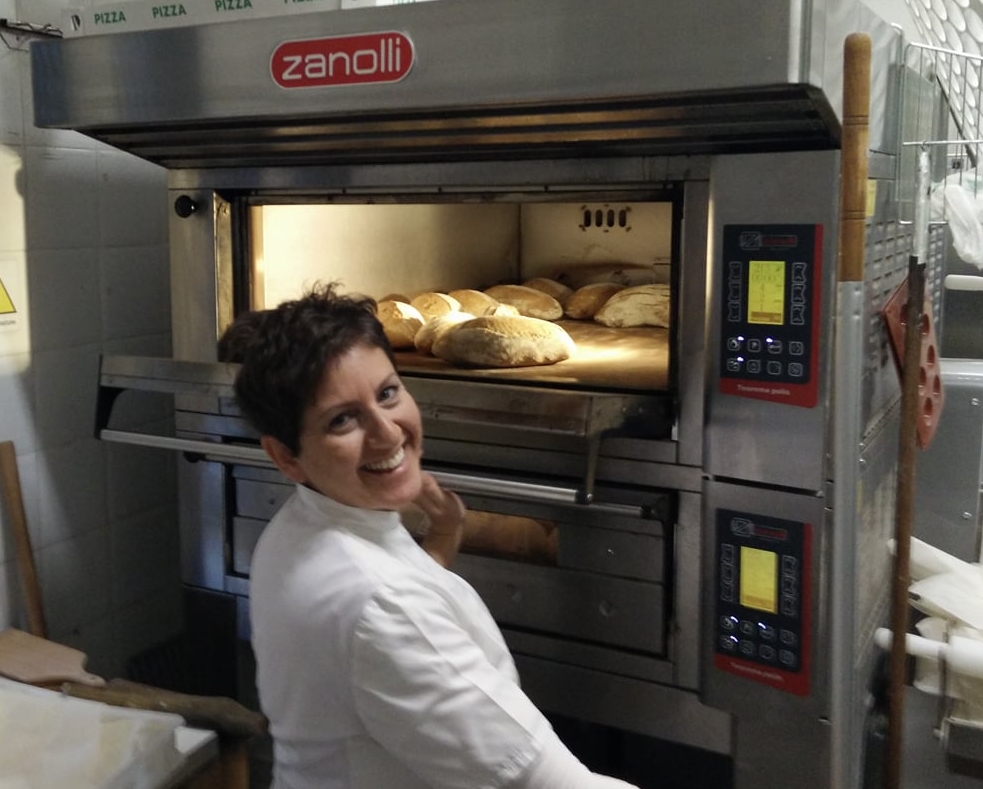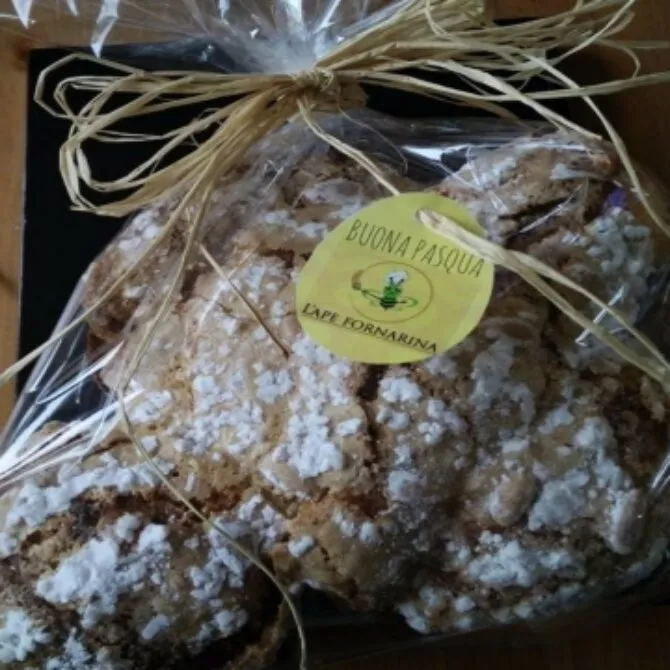We like real and genuine things, we like to know our customers better and better and understand their needs, desires and strengths. We like to work as a team, and we like to think we are the allies of the people who choose us. This is why we want to talk with our customers and spread the excellence they create; other professionals will find inspiration for their work and enthusiasts will discover must try delicacies.
Easter time is right around the corner and Giovanna Venosa’ lab, L’Ape Fornarina, is in full swing. Her organic bread and specialty pastries are something to be talked about; this time around, however, we want to know how they make their Easter Cake. Giovanna uses a Teorema Polis pw bread and pastry oven with refractory stones, because her primary production is stone baked bread. Although she loves bread, Giovanna is also passionate about leavened holiday cake, which requires several days of preparation.
«Mild temperatures are required to bake Easter Cake, especially because of the icing that goes on top. A well-balanced live yeast starter, lots of attention, fresh top-quality ingredients and proper baking procedure are all essential. How the cake is baked is crucial to meeting our customer’s expectations.»

Here is Giovanna’s recipe:
Ingredients for 1 kg of Easter Cake
1 Kneading dough mixture
Starter dough 80 g
Water 90 g
Sugar 60 g
Egg yolks 80 g
Flour 210 g
Butter 50 g
2 Kneading dough mixture
Flour 70 g
Water 20 g
Sugar 50 g
Egg yolks 60 g
Powdered milk 10 g
Aromatic mix 20 g
Butter 50 g
Liquid butter 15 g
Salt 3 g
Candied orange 250 g
The starter dough should be used on the third refresh, after it doubles up. Broken up yeast and water with sugar dissolved in it go in the kneading machine. We turn on the machine and let the dough come together, then we add the egg yolks in two rounds and finish by adding soft butter.
The mixture thus obtained will then go into the dough proofer for 12 hours at a temperature of 28° C, until its volume is tripled.
The water where powdered milk and flour have been diluted is then added to the mixture. When it recovers, we add the egg yolks in several rounds, then the aromatic mix and the butter. When the butter is all kneaded in, we add in the liquid butter and salt and, finally, the candied fruit, very slowly, to avoid tearing the dough.
Then it’s back in the proofer for an hour at 28° C; next, will be tipped over on the counter and broken into the desired weight. Once formed, the cake must be left to rise for 4 to 6 hours at 28° C and 60% humidity. Icing is optionally added for taste.
The ovens are turned on to the desired temperature one hour before baking, to “sweeten up” the chambers, that is, for homogeneous and balanced non-aggressive baking.
The resistance of the top is set to 4 and that of the bottom to 3 with an initial temperature of 180° C which is lowered to 175° C immediately after the cake is put into the oven. 750 g pieces are baked for 40 minutes, keeping the valve closed for the first 15 minutes. The cakes are baked when their internal temperature reaches shows 90/91°, then turned upside down for at least 6/8 hours and packaged. Read the product sheet to learn all there is to know about the Polis oven.
Go ahead! Give it a taste!

We like real and genuine things, we like to know our customers better and better and understand their needs, desires and strengths. We like to work as a team, and we like to think we are the allies of the people who choose us. This is why we want to talk with our customers and spread the excellence they create; other professionals will find inspiration for their work and enthusiasts will discover must try delicacies.
Easter time is right around the corner and Giovanna Venosa’ lab, L’Ape Fornarina, is in full swing. Her organic bread and specialty pastries are something to be talked about; this time around, however, we want to know how they make their Easter Cake. Giovanna uses a Teorema Polis pw bread and pastry oven with refractory stones, because her primary production is stone baked bread. Although she loves bread, Giovanna is also passionate about leavened holiday cake, which requires several days of preparation.
«Mild temperatures are required to bake Easter Cake, especially because of the icing that goes on top. A well-balanced live yeast starter, lots of attention, fresh top-quality ingredients and proper baking procedure are all essential. How the cake is baked is crucial to meeting our customer’s expectations.»

Here is Giovanna’s recipe:
Ingredients for 1 kg of Easter Cake
1 Kneading dough mixture
Starter dough 80 g
Water 90 g
Sugar 60 g
Egg yolks 80 g
Flour 210 g
Butter 50 g
2 Kneading dough mixture
Flour 70 g
Water 20 g
Sugar 50 g
Egg yolks 60 g
Powdered milk 10 g
Aromatic mix 20 g
Butter 50 g
Liquid butter 15 g
Salt 3 g
Candied orange 250 g
The starter dough should be used on the third refresh, after it doubles up. Broken up yeast and water with sugar dissolved in it go in the kneading machine. We turn on the machine and let the dough come together, then we add the egg yolks in two rounds and finish by adding soft butter.
The mixture thus obtained will then go into the dough proofer for 12 hours at a temperature of 28° C, until its volume is tripled.
The water where powdered milk and flour have been diluted is then added to the mixture. When it recovers, we add the egg yolks in several rounds, then the aromatic mix and the butter. When the butter is all kneaded in, we add in the liquid butter and salt and, finally, the candied fruit, very slowly, to avoid tearing the dough.
Then it’s back in the proofer for an hour at 28° C; next, will be tipped over on the counter and broken into the desired weight. Once formed, the cake must be left to rise for 4 to 6 hours at 28° C and 60% humidity. Icing is optionally added for taste.
The ovens are turned on to the desired temperature one hour before baking, to “sweeten up” the chambers, that is, for homogeneous and balanced non-aggressive baking.
The resistance of the top is set to 4 and that of the bottom to 3 with an initial temperature of 180° C which is lowered to 175° C immediately after the cake is put into the oven. 750 g pieces are baked for 40 minutes, keeping the valve closed for the first 15 minutes. The cakes are baked when their internal temperature reaches shows 90/91°, then turned upside down for at least 6/8 hours and packaged. Read the product sheet to learn all there is to know about the Polis oven.
Go ahead! Give it a taste!

You might also be interested in...





